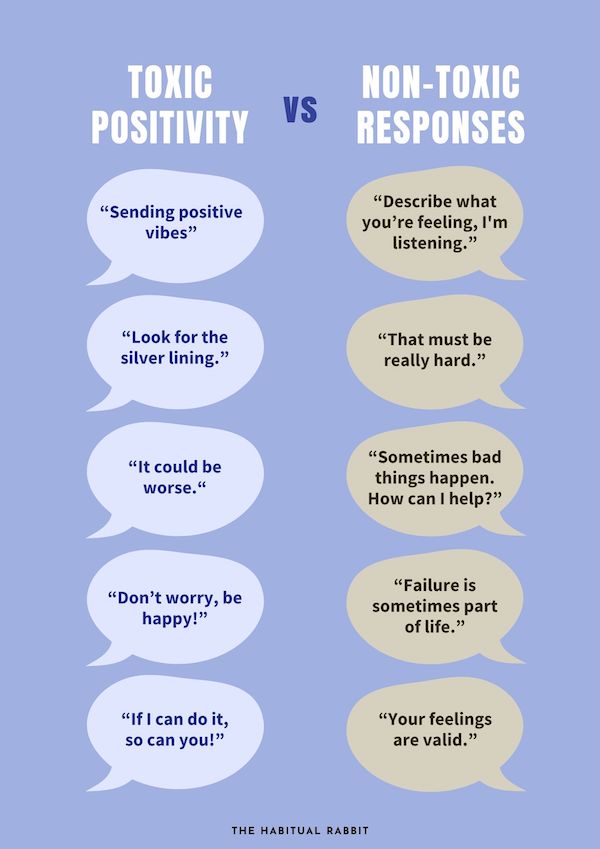
What is Toxic Positivity?
Has anyone ever told you to “just be positive” when you’re anxious or worrying about something? How does that make you feel? Does it actually help to just “think positive thoughts?”
There have been a lot of mixed messages about the idea of positive thinking, but the fact is that positive thinking doesn’t really work.
Don’t get me wrong, there’s nothing wrong with being optimistic. But the whole notion of pushing positivity and positive thinking without addressing the root of the problem is a recipe for disaster and possibly, a mental breakdown.
When you tell someone to be positive, you’re essentially saying to think only positive thoughts, ignore the negative aspects, and avoid acknowledging the struggles you’re facing. This discourages and prevents the acceptance of feelings and emotions. For example, if you express worry about not getting a job, telling yourself “Just be positive, everything will work out” doesn’t address the situation. If you don’t get the job, you’ll think, “Well, what happened? I was being positive.”
This is the limitation of positive thinking.
In my personal experience, I’ve struggled with problem thinking, where everything is perceived as a problem, and I tend to be blindly negative. Toxic positivity, on the other hand, involves being blindly positive without thoughtful consideration or action.
Both positive thinking and problem thinking keep you stuck in the mind, alone, on opposite ends of the spectrum. A balanced approach that acknowledges both positive and negative emotions is key to genuine personal growth and resilience.
Identifying Toxic Positivity
Identifying toxic positivity is crucial for those who want to achieve emotional well-being.
One hallmark of toxic positivity is the dismissal or suppression of negative emotions. When someone is told to “just be positive” or “look on the bright side” without acknowledgment of their struggles, it can lead to emotional repression and an increased sense of isolation. Life is a nuanced journey filled with ups and downs, and expecting relentless positivity oversimplifies the human experience.
For those who lost their money through one of the many scams and hacks, or those who lost a loved one to mass shootings, or for the many sexual assault victims out there, not only does this advice have no practical value, but it is tone-deaf and insensitive to the struggles people face.
Another aspect of toxic positivity is the lack of action or change in behavior that is needed to address deeper-rooted issues surrounding negative thoughts and feelings. There is no benefit in just thinking positive thoughts. You will not “manifest” positive outcomes without aligning your behaviors and habits with those thoughts.
When I’m dealing with high-stakes situations, I choose to be proactive and acknowledge the difficulties rather than just “thinking positive thoughts”. Could I have just lied on my sofa, begged the universe for everything to work out, think positive and do nothing, and have everything just fall into my lap? No, I had to do my research. I had to plan for different scenarios, outcomes, and risks. I had to consult with experts to gather insights. I had to actively make informed decisions to get me to my desired outcome. In the end, I felt at peace knowing that there was evidence that my actions played a major role in resolving a stressful personal event.
More Examples of Toxic Positivity
- When something bad happens, people may say to “just stay positive” or “look on the bright side.” While such comments are often meant to be sympathetic, they can shut down anything the other person might want to say about what they are experiencing.
- After experiencing some type of loss, people might say that “everything happens for a reason.” While people will make such statements because they believe they are comforting, this is also a way of avoiding the other person’s pain.
- Upon expressing disappointment or sadness, someone may respond that “happiness is a choice.” This suggests that if someone is feeling negative emotions, it’s their own fault for not “choosing” to be happy.
Reframing Positive Thinking
One area of investing that I appreciate is hedging. If you treat (toxic) positive thinking as a religion or as a fanatic, hedging can’t exist in your vocabulary pool. It’s about being aware of the idea that there is a possibility that something you want doesn’t go according to plan, that it can go wrong—sometimes horribly wrong.
Hedging is about autonomy and asking, “What can I do about that risk? What can I do to minimize it?”
Here’s an example: someone with only positive thinking might say, “The crypto that I bought has already dropped 99% (maybe 95% if the 2023 rally has helped their situation). It’ll be fine. I’ll pray to the crypto gods, think positive and I will eventually be rewarded. After all, bad things only happen to other people, not me.”
Being mindful of possibilities and taking autonomy in your life would go like this: “Thousands of altcoins have died since the advent of cryptocurrency. I wonder how many people were holders of those ‘assets’ and they told themselves to think positive, only for it to flatline. If I want to invest in this extremely speculative space, I need to first think about how much I am willing to lose and plan my actions around that. Not only that, I should really start hedging my bets by diversifying into different, and preferably, safer investments.”
Possibility thinking
Possibility thinking is a more realistic approach and involves exploring what is possible, discovering options, and uncovering different paths. With this strategy, you’re acknowledging both the positives and negatives and finding a healthy balance.
Since shifting from a problem mindset to possibility thinking, I’ve embraced the idea that there is always another way, door, or possibility. This mindset doesn’t force belief in everything working out perfectly but acknowledges the possibility of things going wrong.
The world is filled with random events every day, how can something not go wrong? It’s about autonomy, taking control, and planning actions in response to risks or setbacks. Possibility thinking is changing the mindset to “how can I make it work” which provides a sense of control.
Instead of toxic positivity responses:
- “Sending positive vibes!”
- “Look for the silver lining.”
- “It could be worse.”
- “Don’t worry, be happy!”
- “If I can do it, so can you!” (this is most definitely the worst one)
Try non-toxic responses when listening to someone:
- “Describe what you’re feeling, I’m listening.”
- “That must be really hard.”
- “Sometimes bad things happen. How can I help?”
- “Failure is sometimes part of life.”
- “Your feelings are valid.”
One thing I like to ask my close friends is “How would you like me to be there for you?” Sometimes, people just want you to listen. Other times, people can’t get out of their problem thinking and need to hear different perspectives and solutions to feel better. Everyone is different, and every situation is different.
Toxic Positivity & Social Media
Toxic positivity is a concept that promotes a positive and happy mindset no matter how difficult a person’s experience is. The power of positive thinking is an idea that books and other media outlets have focused on for decades, but with the growth of social media, the idea has exploded.
Many accounts are promoting positive mantras and encouraging messages meant to be uplifting. In theory, this may seem beneficial; in reality, it can be extremely detrimental and toxic to our social and emotional well-being.
“Positive vibes only!” is a popular message on memes these days, as is “It could be worse” and “Look on the bright side.” Though these expressions may seem harmless, the problem is that they offer just one way to feel. They insinuate that if you aren’t being upbeat and optimistic, then you’re doing something wrong.

Toxic Positivity’s Effects on Mental Health
There’s no doubt that toxic positivity has harmful effects on our mental health. This idea promotes the suppression of negative thoughts and emotions and can lead to feelings of guilt, shame, and inadequacy, as well as a sense of isolation and disconnection from others. Toxic positivity can also create an environment where people feel that they are not allowed to express their true feelings, which can lead to further emotional distress.
Here are specific ways toxic positivity can impede our mental well-being:
- Hindrance to Healing: Processing a full range of emotions is essential for healing and growth. Toxic positivity can hinder this process, delaying recovery from emotional distress.
- Suppression of Emotions: It encourages individuals to suppress negative emotions, which can lead to a build-up of stress and decrease emotional resilience.
- Invalidation of Feelings: By dismissing negative emotions, toxic positivity invalidates a person’s genuine feelings, which can result in a sense of isolation and lack of support.
- Avoidance of Addressing Issues: It can lead to avoidance behaviors, where individuals do not address underlying issues, potentially exacerbating mental health problems.
- Increased Pressure: The pressure to appear happy can create additional stress and anxiety, particularly on social media where there is a tendency to compare oneself with others.
Alternatives to Toxic Positivity (What To Do Instead)
Accept that "it's okay to not be okay"
It’s not realistic to be okay all the time. I mean, who is actually okay all the time? It’s important to accept all the highs and lows that life has to offer and embrace the wide range of emotions we can experience.
Journaling
Instead of just thinking positive thoughts, try putting your feelings into words by journaling. For some, this can be a very therapeutic process. Don’t worry about all the mechanics, just write out your thoughts in their purest form.
Confide in a friend
When going through challenging times, think about ways to give voice to your emotions in a productive way. This could mean confiding in a trusted friend and talking through the difficulties. Like journaling, this could help to process what you’re experiencing.
Try therapy
Therapy is vital in helping you put feelings into words. It can also help validate your feelings and experiences while guiding you to see possibilities. I can honestly say that therapy has helped me tremendously in reframing my mindset.
Limit social media use
Following “positive” social media accounts can sometimes serve as a source of inspiration but pay attention to how you feel after you view and interact with such content. If you are left with a sense of shame or guilt after seeing “uplifting” posts, it might be due to toxic positivity. In this case, consider limiting your social media use.
Look for meaning behind what you're going through
“Tragic optimism,” or searching for the meaning behind difficult situations, is the opposite of toxic positivity and, according to some, is considered the antidote to this type of response. It’s about finding or making meaning of a difficult time in your life.

